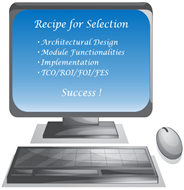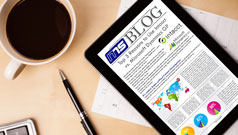
Recipe for Accounting Software Selection

With any good food recipe, one must have the right ingredients to provide the flavor and texture, the right combination and mixture of those ingredients, and the ability to modify the recipe to improve it or have it better fit changing needs. The cost of the ingredients can play a role in the quality of the ingredients purchased. When everything is executed correctly, those who partake of the food are rewarded with a successful and positive experience.
Selecting an accounting software is much like a recipe. The right architectural design(ingredients) is needed to store the organization's financial data, to provide data recall capabilities, to have integration abilities with other applications, and to enable future modification capabilities. The right module functionalities(combination and mixture) are needed to process the organization's data flow. The combination of the software's architecture and functionalities determines the quality of dashboards, reports, and graphs that tell the organization's financial story. Once the accounting software has been selected, the proper implementation(execution) of the software for the organization will provide a successful and positive experience for all involved.
Architectural Design(Ingredients):
A single-tenant (designed to house individual organizations) versus a multi-tenant (designed to house all organizations at once) will determine whether the software is an on-premise design or a cloud design. A single-tenant design can be hosted, but it does not have the same freedom that a multi-tenant has. For example, with a single-tenant design, different organizations can be on different versions of the software, but with a multi-tenant design all organizations are on the same version so everyone has access to the latest functionalities at the same time.
Other architectural designs can determine how the financial data will be stored. For example, some software designs use one field that combines the chart of accounts, departments, locations, and other segments of data, while other software designs use separate fields for the chart of accounts, for the departments, for the locations, for the vendors, and for other types of data. Having one field versus multiple fields determines the quantity of account numbers, the data entry processing, and the reporting capabilities.
The examples above are only two of many differences to consider when selecting the accounting software for your organization.
Module Functionalities(Combination and Mixture):
Organizations need to determine ideally how their business processes would flow if there were no accounting software design restrictions. Once organizations have determined how their business processes should flow, then they can begin to investigate the various accounting software that is available.
For example, if an organization wants its requisition approval workflow to be paperless, the software selected would need to have the desired modular functionality. If the organization wants mobile functionality with its approval workflow, then that would be another functionality the software would need to provide.
There may be some business processes that no accounting software is capable of providing out of the box. If the functionalities are truly desired, then the organization will want to verify that the functionality could be programmed into the selected software. A demo of a software can help determine if the desired functionalities are available.
Implementation(execution):
Organizations can have the best accounting software, but if the implementation process is not properly performed, the end result will not be a positive experience. Implementations consist of uploading master records such as chart of accounts, customers, vendors, items, etc; uploading historical general journals for comparative reporting with the current year to past years; verifying all uploaded data is correct; establishing and training on the new processes for the new accounting software; bringing in outstanding balances for Go-Live day; and support immediately after the Go-Live day.
Summary:
Some choices can be made to help narrow the number of accounting software packages that organizations will need to investigate. Organizations can choose whether to own the software and install it on premise or own it and have it hosted or have a subscription hosted or pay an annual subscription for a true cloud software that is accessible using the internet browsers. (See the article written for the inSight Issue called Which Software Platform to Choose?) Organizations can also choose whether to have a single-tenant or multi-tenant software to help narrow the choices. Using functionalities to narrow the number of choices is usually a more involved process because many times it takes viewing demos to help organizations understand the software's capabilities.
The choices among the various accounting software can also be quantified so that they can be compared dollar for dollar. Those dollar divisions are the TCO (total cost of ownership), ROI (return on investment), FOI (future opportunity investment), and FES (future exit strategy). Visit the links for information on the TCO and ROI.
FOI includes the rate at which an accounting software is upgraded with new features along with its ability to integrate with other software applications that the organization may be currently using or planning to use. It also includes the future stability of the software platform, the training and help updates that stay current with the updated functionalities, the rate of software cost regarding subscription fees, and the ability to select the best support/partner on the software for the organization as time goes on.
FES includes the cost to move the data, including attachments and notes, from the software to a new software sometime in the future. It may be determined that exporting attachments and notes are not possible or the exportation must be performed one attachment or note at a time, which would not be feasible. Therefore, it may be a good investment to subscribe to a document management tool that stores the actual document and provides a link to the document within the accounting software, thereby enabling the document itself to be stored separately from the accounting software. Another consideration is the cost of maintaining the existing software in the future because it will have years of the organization's historical activities, and the organization may want to go back to view its historical data.
Time spent upfront selecting the best accounting software ingredients with the correct mixture of functionality for the organization, with the ability of future modification capabilities, and a properly executed implementation will help the organization be successful and be rewarded with a positive experience.
Contact us to learn more about selecting an accounting software.

